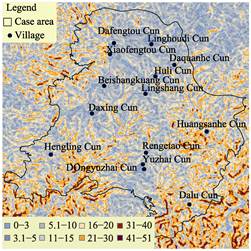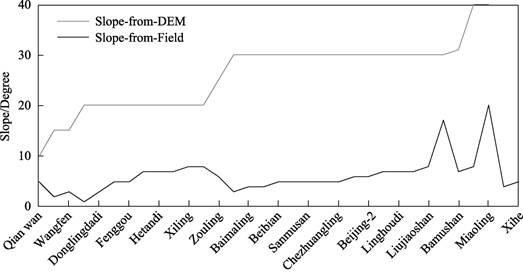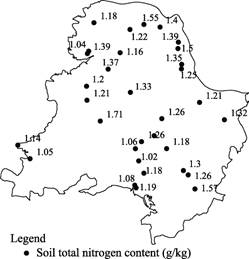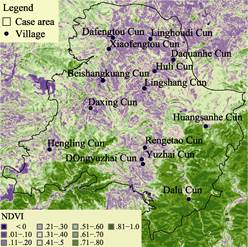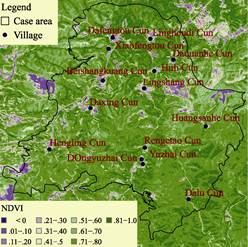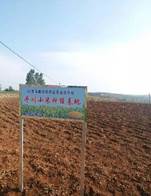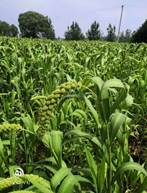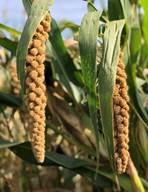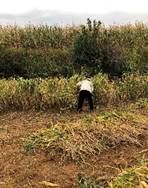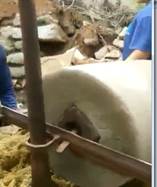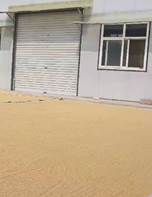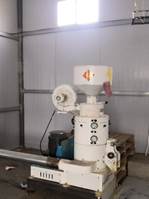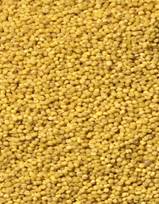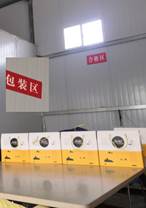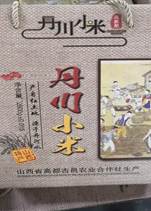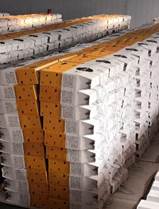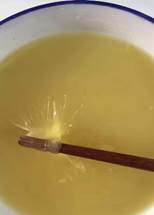Zezhou Millet (Danchuan Millet) Gaodu Township Case in Red Clay Soil
Abstract
Zezhou millet is a geographical indication agricultural product designated by the Ministry of Agriculture and Rural Affairs, and its excellent quality mainly derives from two natural factors of the origin of product: one is the sunshine and temperature in the low hilly areas in the N35°-N36° zone (of the four famous Millet in China in history, 3 are from the hilly area in this zone); the second is the red clay of the Loess Plateau. This case study covers 14 villages in the east of Gaodu town, Zezhou county, Shanxi province. In 2021, the sown acreage of millet in case area is 410 ha, and the yield of millet is 2.11 M kg. The sown acreage and yields of millet in the case area account for 61.56% and 82.25% that of Zezhou, respectively. The red clay is the paleo-soil exposed after the surface loess is eroded, accounting for 2.72% of the soil area of the Loess Plateau. This red clay was difficult to cultivate due to its high clay content and was considered to be poor soil. However, after long-term nurturing by local farmers, the cultivated crops in this soil not only has high yield (5,137 kg/ha), but also has good quality. This case dataset consists of 5 parts: boundary data of the case area (village, town, county); geographic data (topography, soil, vegetation, meteorology); physical and chemical analysis of millet; socio-economic and management data from case area and Gaodu Guyi Agricultural Cooperative; and historical data. The data are in .shp, .tiff, .xls, and .docx format, and are 55.9 MB in size.
Introduction
Millet (Setaria italica var. germanica (Mill.) Schred.) is also called Su or Guzi in the north of China. Its grain is very small, about 1 mm in diameter. Millet originated from China and has a cultivation history of about 10,000 years, and is known as the nurture crop in Chinese traditional culture[1–3]. There are many legends about millet in Taihang Mountain region, and there are a long history of millet cultivation and a unique millet culture. Legend has it that Shennong (Yan Emperor), a tribal leader in ancient China, tasted all kinds of grasses in areas nearby the present case study, and identified and cultivated millet from dogtail grass. Since then, Yan Emperor’s tribe could finally get rid of the turbulent life modal which was totally depending on hunting and gathering. Zezhou millet is a latter part of this early history.
The Zezhou millet is produced in Gaodu town, Zezhou county, Jincheng city (prefecture), Shanxi province. It was awarded the “Geographical Indication Agricultural Product” by the Ministry of Agriculture in 2017[4]. Its grains are glossy, its smells fresh and fragrant, its touch cool, and its taste is slightly sweet. Zezhou millet is rich in nutrients. Millet congee looks golden and tastes sticky. It is a nourishing gruel with high nutritional value. Recognizing its nutrition, locals use millet porridge to nourish patients.
This case study area covers 14 villages in the eastern Gaodu town, and its millet yield accounts for 82.25% of Zezhou county. The soil in the case area is mainly tertiary red clay exposed after the loess surface has been eroded, accounting for 2.72% of the soil on the Loess Plateau[5]. Soil conservation and cultivation for years have made the soil so fertile to plant the millet. In addition, the case area is located in the golden climate zone for millet near 36°N, producing 3 of the 4 best millets in China[6].
Metadata of the Dataset
The metadata of Zezhou millet (Danchuan millet) Gaodu red clay case dataset on ecosystem protection and sustainable development[7] is summarized in Table 1.
Table 1 Metadata summary of Zezhou millet (Danchuan millet) Gaodu red clay case dataset on ecosystem protection and sustainable development[7]
| Items | Description |
|---|---|
| Dataset full name | Zezhou millet (Danchuan millet) Gaodu red clay case dataset on ecosystem protection and sustainable development |
| Dataset short name | ZezhouMilletCase10 |
| Authors | Zhang, A.Y., Millet Research Institute, Shanxi Agricultural University, zay1012@126.com Hao, Z. F., Institute of Crop Sciences, Chinese Academy of Agricultural Sciences, haozhuanfang@caas.cn Zhang, J. J., Government of Gaodu town, Zezhou county, Shanxi province Guan, J. S., Government of Gaodu town, Zezhou county, Shanxi province Jiao, L., Agricultural Professional Cooperative in Gaodu Guyi, Zezhou county, Shanxi province, Jiao, H. L., Gaodu Guyi Agricultural Professional Cooperative, Zezhou county, Shanxi province Hao, Q.Q., Shanxi Jincheng Xingdian Surveying and Mapping limited company, 13994708771@139.com Wang, F., Institute of Soil and Water Conservation, Ministry of Water Resources, Chinese Academy of Sciences, wafe@ms.iswc.ac.cn Yang, L. B., Center for Science and Technology Innovation and Development, Chinese Academy of Sciences, lbyang@stidc.ac.cn Wang, Z. X., L-5255-2016, Institute of Geographical Sciences and Natural Resources Research, Chinese Academy of Sciences, wangzx@igsnrr.ac.cn |
| Geographical region | 14 villages in eastern Gaodu town, Zezhou county, Shanxi. Centered at 113°5¢E, 35°35¢N. |
| Year | 2001-2020 |
| Data format | .shp, .tif, .xlsx, .docx, .jpg |
| Data size | 55.9 MB |
| Data files | Location and scope of the case area; physical geography; millet variety; millet management; photos and pictures. |
| Foundation | National key research and development project (2020YFD1000803-2) |
| Data publisher | Global Change Research Data Publishing & Repository, http://www.geodoi.ac.cn |
| Address | No. 11A, Datun Road, Chaoyang District, Beijing 100101, China |
| Data sharing policy | Data from the Global Change Research Data Publishing & Repository includes metadata, datasets (in the Digital Journal of Global Change Data Repository), and publications (in the Journal of Global Change Data & Discovery). Data sharing policy includes: (1) Data are openly available and can be free downloaded via the Internet; (2) End users are encouraged to use Data subject to citation; (3) Users, who are by definition also value-added service providers, are welcome to redistribute Data subject to written permission from the GCdataPR Editorial Office and the issuance of a Data redistribution license; and (4) If Data are used to compile new datasets, the ‘ten per cent principal’ should be followed such that Data records utilized should not surpass 10% of the new dataset contents, while sources should be clearly noted in suitable places in the new dataset[8] |
| Communication and searchable system | DOI, CSTR, Crossref, DCI, CSCD, CNKI, SciEngine, WDS/ISC, GEOSS |
DOI: https://doi.org/10.3974/geodp.2021.04.06
CSTR: https://cstr.escience.org.cn/CSTR:20146.14.2021.04.06
Dataset Availability Statement:
The dataset supporting this paper was published and is accessible through the Digital Journal of Global Change Data Repository at: https://doi.org/10.3974/geodb.2021.12.45.V1 or https://cstr.escience.org.cn/CSTR:20146.11.2021.12.45.V1
Physical Geography of the Case Area
Location and Scope
Gaodu town is located in the southeast of Shanxi province, 20 km northeast of Jincheng city, and bordering Lingchuan couty, Bagong town, Jincun town, and Beiyi town. The Zezhou millet case area covers 14 villages, including Daxing, Hengling, Beishangkuang, Dalu, Shanhuo, Fengtou, Mayu, Lingshang, etc. in the east of Gaodu town, with a total area of 41 km2. The geographic coordinates center at 113°5′E, 35°35′N (Figure 1, 2), which is located near the golden latitude zone of 36°N for grain production.
| Figure 1 Location of the case area in Shanxi province and the Loess Plateau region | Figure 2 Scope of the case area in Zezhou county |
|---|---|
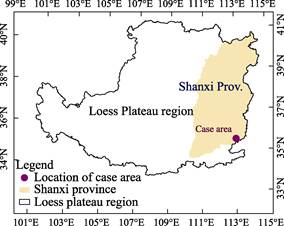 |
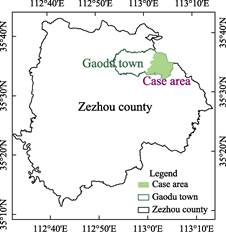 |
Topography: DEM and Slope
The case area is dominated by hills, and millets are mainly sown on the relatively flat middle and upper hills, with an altitude of 800-1,050 m (Figure 3, 4). While some surface slopes derived from DEM appear steep, the actual slope from the field survey is much smaller. For example, among the 33 sample plots, only 2 plots have actual slopes between 10 and 20 degrees, and the remaining plots are below 10 degrees (Figure 5). The land use complies with the provisions of the National Soil and Water Conservation Law.
Soil: Red Clay
The soil type of selected field for millet is mainly red clay. The soil data was collected from 33 samples (Figure 6, 7). The nutrients in the 33 soil samples is shown in Table 2: each sample includes pH, total nitrogen, total phosphorus, total potassium, available nitrogen, available phosphorus, available potassium, organic matter and other 17 elements. The soil samples were analyzed following the methods of Lu[9]. Soil of pH>7.5 was classed into alkaline soil, and the soil indicators meet the secondary standard of soil environmental quality, in line with the environmental standard of agricultural land[10–12]. The organic matter contents range between 14.1-34.5 g/kg, of which 25 points are more than 20 g/kg. Total nitrogen and available potassium are all in rich or better level; 26 of 30 samples have a rich or better grade for available phosphorus; 7 of 30 samples have a rich or better grade for alkaline hydrolyzable nitrogen; and 16 of 30 samples have a rich or better grade for copper (Table 2).
Table 2 Statistics of element content from 33 soil samples in case area
| No. | Test items | Sample range | Sample mean | Typical plot | Level | Soil assessment reference value | ||||
|---|---|---|---|---|---|---|---|---|---|---|
| Extremely lack | Lack | Moderate | Rich | Extremely rich | ||||||
| 1 | pH | 7.5-8.1 | 7.69 | 8 | partial alkali | <5.5 | 5.5- 6.5 | 6.5-7.5 | 7.5-8.5 | >8.5 |
| 2 | Alkali-hydrolyzable nitrogen (mg/kg) | 32.8- 107 | 68.73 | 37.6 | Lack | <30.00 | 30-60 | 60-90 | 90-120 | >120 |
| 3 | Effective Phosphorous (mg/kg) | 6.3-25 | 14.18 | 11.2 | Richer | <3.0 | 3.0- 5.0 | 5.0-10.0 | 10.0-20.0 | >20.0 |
| 4 | available potassium (mg/kg) | 131- 586 | 227.15 | 197 | Rich | <30 | 30-50 | 50-100 | 100-150 | >150 |
| 5 | Soil organic matter (g/kg) | 14.1- 34.5 | 23.58 | 20.2 | Richer | <6.0 | 6.0- 10.0 | 10.0- 20.0 | 20.0-30.0 | >30 |
| 6 | Total nitrogen (g/kg) | 1.02- 1.71 | 1.27 | 2.15 | Extremely rich | <0.65 | 0.65-0.80 | 0.80- 1.00 | 1.00-1.20 | >1.20 |
| 7 | Total phosphorus (g/kg) | 0.63- 0.92 | 0.76 | 1.09 | Extremely rich | <0.50 | 0.50-0.75 | 0.75- 1.00 | 1.00-1.50 | >1.50 |
| 8 | Total potassium (g/kg) | 17.1-20 | 18.93 | 28.4 | Extremely rich | <3.0 | 3.0- 5.0 | 5.0-10.0 | 10.0-15.0 | >15.0 |
| 9 | Slowly effective potassium (mg/kg) | 562- 1,368 | 968.48 | - | ||||||
| 10 | Effective copper (mg/kg) | 0.45- 1.32 | 0.99 | 2.76 | Extremely rich | <0.1 | 0.1- 0.2 | 0.2-1.0 | 1.0-1.8 | >1.8 |
| 11 | Effective Zinc (mg/kg) | 0.57- 3.08 | 1.04 | 2.44 | Rich | <0.3 | 0.3- 0.5 | 0.5-1.0 | 1.0-3.0 | >3.0 |
| 12 | Available iron (mg/kg) | 1.3-5.9 | 4.13 | 7.32 | Moderate | <2.5 | 2.5- 4.5 | 4.5-10.0 | 10.0-20.0 | >20.0 |
| 13 | Available manganese (mg/kg) | 0.3-7.8 | 3.87 | 6.84 | Moderate | <1.0 | 1.5- 5.0 | 5.0-15.0 | 15-30 | >30 |
| 14 | Cation exchange capacityc (mol/kg) | 20.1- 28.9 | 23.76 | - | ||||||
| 15 | Water soluble boron (mg/kg) | 0.36- 0.85 | 0.54 | - | ||||||
| 16 | Effective molybdenum (mg/kg) | 0.3- 0.42 | 0.36 | - | ||||||
| 17 | Effective sulphur (mg/kg) | 9.8- 46.5 | 28.00 | - |
Climate: Temperate Monsoon with Concurrent Rain and Heat
The Gaodu town has a typical temperate continental monsoon climate with four distinct seasons. It is dry and windy in spring, hot and rainy in summer, pleasantly cool in autumn, and cold and dry in winter. The annual sunshine is between 2,393 and 2,630 hours, with an average of 2,563 hours. The annual average temperature is 11-13 °C, and the frost-free period in the town is 192.6 days, with a maximum of 226 days and a minimum of 138 days. The days with the highest temperature corresponds to the growing season of millet (Figure 8); the average annual precipitation is 450-860 mm (Figure 9), and the precipitation is mainly in July, August and September, which is exactly the water-requiring time of jointing-heading and grain-filling periods in millet, accounting for 60% of the annual precipitation. While there are some fluctuations in precipitation and temperature between years (Figure 10, 11), the climatic conditions are generally suitable for millet growth.
Land Cover: NDVI
Figure 12 is the Sentinel Satellite NDVI on May 10, 2020, which showed the vegetation coverage before planting or seedling stage of autumn crops in case area. Although the map shows that most of the surface lacks vegetation, this bare land is seasonal. Figure 13 shows the NDVI from Sentinel-2 satellite on August 10, 2020. In this season, except for a few farmlands in fallow due to different phenology, most vegetation, including millet, is in the heyday of vegetation coverage. There is no obvious soil erosion on the surface.
Characteristics of Zezhou Millet Varieties
Agronomic Characteristics of Zezhou Millet
In 2020, Jingu 21 was selected as the main millet variety due to its high-yield, high-quality, lodging-resistant, stress-resistant and its adaptability[13]. The seedlings of this variety are deep green with a single culm, and the height of main stem is 146-157 cm, the stem diameter is 0.66 cm, and the number of main stem nodes is 23. The ear of this variety is cylindrical, the ear length is 22-25 cm, the gross weight per ear is 22.0-24.5 g, the net weight per ear (grain) is 16.7-22.7 g with 75%-90% coarse grain and 70%-80% fine grain, and the thousand-grain weight is 3.0-3.3 g. The weight of a single millet grass is 46 g, and the ratio of grain to grass is 1:2.3.
Nutritional Characteristics of Zezhou Millet
The physical and chemical analysis of millet grains in Gaodu town was conducted by the Grain and Product Quality Supervision, Inspection and Testing Center (Harbin) of the Ministry of Agriculture and Rural Affairs. Zezhou millet contains carbohydrates, proteins, amino acids, fats and fatty acids, vitamins, and minerals. Nutritionally, the protein and fat content exceeded the local standard of DB/1300 B22 13―90[14]. The grains contain 15.12% crude protein, 5.76% fat, 73.84% starch, 0.28% lysine, and 85.54% total unsaturated fatty acids. Each kilogram of millet contains 153.8 mg of calcium, 53 mg of iron, and 30.9 mg of zinc. The consistency of millet glue is 150 mm, and the alkali elimination index is 2.1.
The grain beige is golden and shiny, and the particles are perfect, crystal clear, japonica, soft and smooth, rich in nutrition, sweet and delicious. Compared with rice, the content of mineral trace elements in millet is characterized by higher content of K, Fe and P, and the content of Se, Mg, Zn and K in millet is 0.06 mg/100g, 993 mg/kg, 23 mg/kg and 207 mg/100g, respectively. Especially, selenium exists in the form of organic condition (Table 3). In addition, the content of polyphenols in millet is about 0.3%-3%, which has strong antioxidant activity.
Table 3 Nutrient content of Zezhou millet
| Quality parameters | Unit | Nutrient content | Testing method | DB/1300 B22 13—90 [14] |
|---|---|---|---|---|
| Crude protein (dry basis) | g/100g | 12.1 | GB 5009.5—2016 | >11.8 |
| Crude fat (dry basis) | g/100g | 4.5 | GB 5009.6—2016 | >4.2 |
| Crude starch (dry basis) | % | 79.27 | NY/T 11—1985 | |
| Amylose (by weight of starch) | % | 26.6 | NY/T 55—1987 | 17.1-20 |
| Alkali consumption value | unitless | 4.1 | - | >2.5 |
| Gum consistency | mm | 121 | - | >115 |
| Vitamin B1 | mg/100g | 0.282 | GB 5009.5—2016 | |
| Vitamin B2 | mg/100g | 0.023,9 | GB 5009.6—2016 | |
| Selenium (as Se) | mg/100g | 0.060 | GB 5009.93—2017 | |
| Phosphorus (P) | mg/100g | 117 | GB 5009.6—2016 | |
| Potassium (K) | mg/100g | 207 | GB 5009.93—2017 | |
| Sodium (Na) | mg/100g | 2.54 | GB 5009.93—2017 | |
| Copper (Cu) | mg/kg | 5.3 | GB 5009.93—2017 | |
| Iron (Fe) | mg/kg | 26.7 | GB 5009.90—2016 | |
| Zinc (Zn) | mg/kg | 23 | GB 5009.93—2017 | |
| Magnesium (Mg) | mg/kg | 993 | GB 5009.93—2017 | |
| Calcium (Ca) | mg/kg | 71.1 | GB 5009.92—2016 |
Millet Management in Case Area
Socio-economics of Case Area in 2020
There are 2,472 households in the 14 villages in the east of Gaodu town, with 7,522 people and 1,335.86 ha of arable land in 2020. The sown area of millet was 410.27 ha, and the total yield was 2.11 million kg (Table 4). The sown area and yield of millet in case area account for 61.56% and 82.25% of Zezhou county, respectively, and is the core area of millet in Zezhou county.
Table 4 Production status of 14 villages in Gaodu town
| Number | Village/ Natural village | Households | Population | Arable land (ha) | Millet area, (ha) | Millet yield (kg/ha) | Millet yield (104 kg) |
|---|---|---|---|---|---|---|---|
| 1 | Hengling | 190 | 541 | 87.73 | 40.00 | 3,750.00 | 15.00 |
| 2 | Huli | 111 | 332 | 82.80 | 43.33 | 6,000.00 | 26.00 |
| 3 | Lingshang | 433 | 1,253 | 200.33 | 84.00 | 6,000.00 | 50.40 |
| 4 | Huangsanhe Natural | 58 | 135 | 37.67 | 17.33 | 6,000.00 | 10.40 |
| 5 | Daquanhe | 150 | 524 | 70.67 | 20.00 | 4,500.00 | 9.00 |
| 6-9 | Dong Yuzhai / East Yuzhai, Yuzhai, Rengetao, Dalu | 356 | 1,126 | 226.67 | 40.00 | 5,250.00 | 21.00 |
| 10 | Daxing | 364 | 1,182 | 207.67 | 57.67 | 5,250.00 | 30.28 |
| 11 | Xiaofengtou Natural | 80 | 251 | 41.00 | 11.00 | 4,500.00 | 4.95 |
| 12 | Beishang kuang | 248 | 728 | 128.00 | 26.67 | 4,500.00 | 12.00 |
| 13 | Dafengtou | 233 | 690 | 125.99 | 23.60 | 4,500.00 | 10.62 |
| 14 | Linghoudi | 249 | 760 | 127.33 | 46.67 | 4,500.00 | 21.00 |
| Total/Average | 2,472 | 7,522 | 1,335.86 | 410.27 | 5,137.50 | 210.65 |
Technical Specification for Zezhou Millet Cultivation in Case Area
Planting and Field Management
Figure 14 displays the main periods of Zezhou millet cultivation. Firstly, based on long-term experience, flat red clay fields are selected for millet. These lands should be rotated reasonably to regulate soil nutrients and reduce diseases and pests (Figure 14-1). Then, cooperatives provide farmers with seeds and technical services (Figure 14-2). Seed treatment: 2-3 days before sowing, choose a sunny day, and spread the seeds evenly on the ground at noon to dry the seeds. One day before sowing, remove the chaff seeds with clean water, and then soak them in 10% saline solution. Wash the sunken and full seeds with clean water and dry them for sowing. Millet sowing methods include sowing, hole sowing and drill sowing. The sowing amount of millet is generally about 7.5 kg/ha, and the sowing depth is about 3-5 cm. After sowing, the soils are pressed to facilitate seed water absorption and germination (Figure 14-2, 14-3).
Harvesting and Storage
The harvest time is generally from late September to mid October, when the lower leaves of millet turn yellow, the upper leaves are slightly greenish or yellowish green, and the grains become hard (Figure 14-4). In order to ensure quality and traceability, the millet of each plot should be harvested, transported, threshed, and stored independently. The harvested millet should be dried in time. The drying site should not be on the cement ground to avoid mildew due to high moisture. Dried millet should not be mixed with toxic, harmful, corrosive, odorous, volatile and other substances.
Product Processing
The processing of Zezhou millet follows relevant national standards which requires that the cooperative has a production license and the staff has a health certificate. Zezhou millet is processed by traditional stone milling. Due to the relatively low operation temperature of stone milling, the damage of high temperature to the quality of millet is avoided, and the rich minerals, vitamins and other nutrients in the epidermis of millet are retained (Figure 14-5, 14-6). Millet processing consists of cleaning, hulling, milling, grading, color selection, measurement, packaging, and inspection. Zezhou millet production archives record the information of production environment, production technology, pest control, harvesting, and processing. These archives shall be kept for at least 5 years.
| Figure 14 Main periods for Zezhou millet cultivation, processing and quality control |
|---|
Traditional Culture of Zezhou Millet
Zezhou millet has a long history. According to Zezhou encyclopedia, the best Zezhou millet is produced in Daxing village. The millet is famous for its golden color, round and bright particles, rich nutrition, sweet and delicious taste. According to legend, Zhang Min, a Minister of military affairs of the Ming Dynasty, presented “Daxing millet” from his hometown (Daxing village) as a tribute to the emperor. The excellent quality of the millet was praised by the emperor, and “Zezhou millet” became famous from then on. Indeed, due to its short growth period, wide adaptability, good storage stability and low price, Zezhou millet has long been loved by the local people.
Discussion and Conclusion
The altitude of Zezhou millet area is 741-1,076 m, with high altitude, large temperature difference between day and night and short sunshine time. It is not only conducive to the accumulation of most amino acids and proteins, but also has high VB2, potassium, copper and zinc contents in millet. The millet produced in this area has low gelatinization temperature and high gel consistency, so the millet planted under this climatic condition has excellent nutritional quality and good palatability[15]. The millet planted on red clay not only has high contents of methionine, glycine, cystine and isoleucine, but also has high contents of fat, magnesium, iron and copper[15]. Therefore, the unique geographical environment of 14 villages in the case area has created the unique quality of Zezhou millet.
In addition to the unique natural conditions, the standardized management of millet production in Zezhou covers soil selection, millet variety selection, field operation, millet harvest, millet processing, and production archives. All of these provide a guarantee and lay the foundation for the establishment of the Geographical marked brand of Zezhou millet.
The case area (14 villages in the east of Gaodu town, Zezhou county) is located in the southeast edge of the Loess Plateau region and shares 36°N with other three high-quality millet in China. Through the analysis of geographic data and ground sample data, the farmland in the case area is mainly horizontal terrace, the actual slope is mainly within 10 degrees, the surface is rich in organic matter and nutrient elements, the vegetation coverage is good in rainy season and there is no obvious soil erosion. Its unique climatic conditions and the tertiary red clay soil are the two main natural factors for the quality of Zezhou millet. A series of millet cultivation specifications have transformed superior natural conditions into a high-quality Zezhou millet, and ensured its sustainability.
References
[1] Yang, X. Y., Wan, Z. W., Perry, L., et al. Early millet use in northern China [J]. Proceedings of the National Academy of Sciences of the United States of America, 2012, 109(10): 3726-3730.
[2] Bettinger, R. L., Barton, L., Morgan, C. The origins of food production in north China: a different kind of agricultural revolution [J]. Evolutionary Anthropology, Issues, News, and Reviews, 2010, 19(1): 9-21.
[3] Lu, H. Y., Zhang, J, P., Liu, K. B., et al. Earliest domestication of common millet (Panicum miliaceum) in East Asia extended to 10,000 years ago [J]. Proceedings of the National Academy of Sciences of the United States of America, 2009, 106(18): 7367-7372.
[4] Public Notice on the Registration of Geographical Indications of Agricultural Products of the People’s Republic of China [2017] No. 5 [DB/OL]. http://www.moa.gov.cn/govpublic/ncpzlaq/201801/t20180118_
[5] 6135301.htm.
[6] Comprehensive Scientific Expedition Team of the Loess Plateau, Chinese Academy of Sciences. Soil resources and utilization in the Loess Plateau [M]. Beijing: China Science and Technology Press, 1991.
[7] Wang, B. Four famous millets in China—a brief introduction of origin [J]. Heilongjiang Grain, 2015, 45-48.
[8] Zhang, A. Y., Hao, Z. F., Zhang, J. J., et al. Zezhou millet (Danchuan millet) Gaodu red clay case dataset on ecosystem protection and sustainable development [J/DB/OL]. Digital Journal of Global Change Data Repository, 2021. https://doi.org/10.3974/geodb.2021.12.45.V1. https://cstr.escience.org.cn/CSTR: 20146.11.2021.12.45.V1.
[9] GCdataPR Editorial Office. GCdataPR data sharing policy [OL]. https://doi.org/10.3974/dp.policy.2014.05 (updated in 2017).
[10] Lu, R. K. Soil agrochemical analysis methods [M]. Beijing: China Agricultural Science and Technology Press, 2000.
[11] National Soil Survey Office. Chinese Soil [M]. Beijing: China Agriculture Press, 2002.
[12] Shi, W. J., Wang, J. K., Bian, Z. X., et al. Distribution and evaluation of main heavy metals and available microelements in soils in the northern area of Heilongjiang province [J]. Chinese Journal of Soil Science, 2005(6): 66-69.
[13] National Soil Survey Office. China Soil Census Technology [M]. Beijing: Agriculture Press, 1982: 111.
[14] Lu, P. Liu, M. X. Chinese Millet Varieties (1986-2010) [M]. Beijing: China Agricultural Press, 2016: 203.
[15] Local Standard of Hebei Province. High-Quality Edible Millet and Its Detection Method (DB/1300 B22 13—90) [S]. 1990.
[16] Zhang, A. Y., Guo, E. H., Diao, X. M., et al. Effects of different types of climate and soil on foxtail millet quality [J]. Scientia Agricultura Sinica, 2019, 52(18): 3218-3231.
Case Team
Principle Investigator
Principle Investigator Zhang Aiying
Zhang Aiying, born in 1977, holds a master's degree, is an associate Professor, and serves as a supervisor for master's students. Expert in the foxtail millet system in Shanxi Province, Director of the foxtail millet cultivation room, Member of the Millet Crop Professional Committee of the Chinese Crop Society, and Member of the Miscellaneous Grain Branch of the Chinese Agricultural Society. She has been engaged in scientific research on the cultivation physiology of foxtail millet and the breeding of new foxtail millet varieties for a long time. She has successively led sub projects of national key research and development projects, self selection of advantageous projects of the institute, and school breeding engineering projects.She has participated in more than ten projects such as the national modern agricultural industry system, national scientific and technological support, and national key research and development. Published over 40 papers in international and national academic journals, of which 6 were included in SCI. Obtained 8 national patents and formulated 4 local standards in Shanxi Province. Received 1 second prize of China Agricultural Science and Technology Award and 1 second prize of Shanxi Province Rural Technology Contracting Award; Breeding Changgu 1, Changnong 41, and Changnong 44 through national or provincial identification; 10 varieties, including Changnong 35, Changnong 36, Changnong 38, Changnong 39, Changnong 40, Changnong 41, Changnong 44, Changnong 46, Changnong 47, and Changnong 48, have been registered as national non crop varieties; Changnong 41 and Changnong 44 have been granted variety protection rights. Together with the members of the research group, worked hard to tackle various scientific research tasks, carried out experimental demonstrations and new variety breeding, participated in the formulation of various technical regulations for millet production, played an important role in millet production and technical support, and also played a positive role in research in this field.
Expert members of the case team
Hao Zhuanfang, Professor, Institute of Crop Science of Chinese Academy of Agricultural Sciences
Zhang Jianjun, own Mayor, Gaodu Town Government of Zezhou County
Guan Junsheng, Director of Gaodu Office of Zezhou County Natural Resources Bureau
Jiao Ling, General Manager, Gaodu Guyi Agricultural Professional Cooperative
Jiao Honglin, Vice General Manager, Gaodu Guyi Agricultural Professional Cooperative
Hao Qiqi, engineer, Shanxi Jincheng Xingdian surveying and mapping Co.,Ltd
Wang Fei, Deputy Director, Institute of soil and water conservation, Ministry of water resources of Chinese Academy of Sciences
Yang Libin, Section Chief, Science and technology innovation and development center of Chinese Academy of Sciences
Wabg Zhengxing, Associate Professor, Institute of Geographic Sciences and Natural Resources Research, Chinese Academy of Sciences
Author Contributions
Zhang, A. Y. and Hao, Z. F. are responsible for data analysis and thesis writing. Zhang, J. J. and Guan, J. S. collected the soil data of the case area. Jiao, L. and Jiao, H. L. collect agricultural cooperative information and millet data. Hao, Q. Q. is in charge of the boundary data. Wang, F. collected meteorological data. Yang, L. B. is responsible for team organization and coordination, and product marketing. Wang, Z. X. processed DEM and NDVI data.
Acknowledgments
This study was guided and assisted by professor Liu, C. of the Institute of Geographic Sciences and Natural Resources Research, Chinese Academy of Sciences. The authors would like to express their sincere gratitude.

